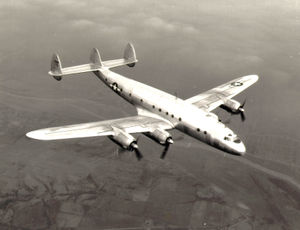Lockheed Constellation
| Constellation | |
|---|---|
 |
|
| A USAF C-69, the military version of the Constellation | |
| Role | Airliner and transport |
| Manufacturer | Lockheed |
| First flight | January 9, 1943 |
| Introduction | 1943 with USAAF 1945 with TWA |
| Retired | 1990s, airline service 1978, military |
| Status | In very limited service |
| Primary users |
Trans World Airlines Eastern Air Lines Pan American World Airways Air France |
| Produced | 1943–1958 |
| Number built | 856 |
| Developed from | L-044 Excalibur |
| Variants |
L-049 Constellation C-69 Constellation L-649 Constellation L-749 Constellation L-1049 Super Constellation C-121/R7V Constellation R7V-2/YC-121F Constellation EC-121 Warning Star L-1649A Starliner |
| Developed into | Lockheed XB-30 (Unbuilt) |
The Lockheed Constellation ("Connie") was a propeller-driven, four-engined airliner built by Lockheed Corporation between 1943 and 1958 at Burbank, California. Lockheed built 856 in numerous models—all with the same triple-tail design and dolphin-shaped fuselage. Most were powered by four 18-cylinder Wright R-3350 Duplex-Cyclones. The Constellation was used as a civil airliner and as a military and civilian air transport, seeing service in the Berlin and the Biafran airlifts. Three of them served as the presidential aircraft for Dwight D. Eisenhower.
Lockheed had been working on the L-044 Excalibur, a four-engine, pressurized airliner, since 1937. In 1939, Trans World Airlines, at the instigation of major stockholder Howard Hughes, requested a 40-passenger transcontinental airliner with a range of 3,500 mi (5,630 km)—well beyond the capabilities of the Excalibur design. TWA's requirements led to the L-049 Constellation, designed by Lockheed engineers including Kelly Johnson and Hall Hibbard.Willis Hawkins, another Lockheed engineer, maintains that the Excalibur program was purely a cover for the Constellation.
The Constellation's wing design was close to that of the P-38 Lightning, differing mostly in size. The triple tail kept the aircraft's height low enough to fit in existing hangars, while features included hydraulically boosted controls and a de-icing system used on wing and tail leading edges. The aircraft had a maximum speed of over 375 mph (600 km/h), faster than that of a Japanese Zero fighter, a cruise speed of 340 mph (550 km/h), and a service ceiling of 24,000 ft (7,300 m).
...
Wikipedia
